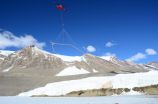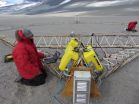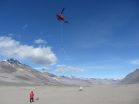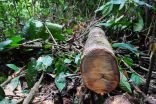Scientists discover salty aquifer, previously unknown microbial habitat under Antarctica
2015-04-28
(Press-News.org) HANOVER, N.H. - Using an airborne imaging system for the first time in Antarctica, scientists have discovered a vast network of unfrozen salty groundwater that may support previously unknown microbial life deep under the coldest, driest desert on our planet. The findings shed new light on ancient climate change on Earth and provide strong evidence that a similar briny aquifer could support microscopic life on Mars.
The study appears in the journal Nature Communications. It is available through open access. A PDF of the study, photos and video also are available on request.
The scientists used SkyTEM , an airborne electromagnetic sensor, to detect and map otherwise inaccessible subterranean features. The system uses an antennae suspended beneath a helicopter to create a magnetic field that reveals the subsurface to a depth of about 1,000 feet. Because a helicopter was used, large areas of rugged terrain could be surveyed. The SkyTEM team was funded by the National Science Foundation and led by researchers from the University of Tennessee, Knoxville, and Dartmouth College, which oversees the NSF's SkyTEM project.
"These unfrozen materials appear to be relics of past surface ecosystems and our findings provide compelling evidence that they now provide deep subsurface habitats for microbial life despite extreme environmental conditions," says lead author Jill Mikucki, an assistant professor at UTK. "These new below-ground visualization technologies can also provide insight on glacial dynamics and how Antarctica responds to climate change."
Co-author Dartmouth Professor Ross Virginia is SkyTem's co-principal investigator and director of Dartmouth's Institute of Arctic Studies . "This project is studying the past and present climate to, in part, understand how climate change in the future will affect biodiversity and ecosystem processes," Virginia says. "This fantastic new view beneath the surface will help us sort out competing ideas about how the McMurdo Dry Valleys have changed with time and how this history influences what we see today."
The researchers found that the unfrozen brines form extensive, interconnected aquifers deep beneath glaciers and lakes and within permanently frozen soils. The brines extend from the coast to at least 7.5 miles inland in the McMurdo Dry Valleys, the largest ice-free region in Antarctica. The brines could be due to freezing and/or evaporation of a large ancient lake or much older ocean deposits. The findings show for the first time that the Dry Valleys' lakes are interconnected rather than isolated; connectivity between lakes and aquifers is important in sustaining ecosystems through drastic climate change, such as lake dry-down events. The findings also challenge the assumption that parts of the ice sheets below the pressure melting point are devoid of liquid water.
In addition to providing answers about the biological adaptations of previously unknown ecosystems that persist in the extreme cold and dark of the Antarctic winter, the new study could help to scientists to understand whether similar conditions might exist elsewhere in the solar system, specifically beneath the surface of Mars, which has many similarities to the Dry Valleys. Overall, the Dry Valleys ecosystem -- cold, vegetation-free and home only to microscopic animal and plant life -- resembles, during the Antarctic summer, conditions on the surface on Mars.
SkyTEM produced images of Taylor Valley along the Ross Sea that suggest briny sediments exist at subsurface temperatures down to perhaps -68°F, which is considered suitable for microbial life. One of the studied areas was lower Taylor Glacier, where the data suggest ancient brine still exists beneath the glacier. That conclusion is supported by the presence of Blood Falls, an iron-rich brine that seeps out of the glacier and hosts an active microbial ecosystem.
Scientists' understanding of Antarctica's underground environment is changing dramatically as research reveals that subglacial lakes are widespread and that at least half of the areas covered by the ice sheet are akin to wetlands on other continents. But groundwater in the ice-free regions and along the coastal margins remains poorly understood.
INFORMATION:
Co-authors on the paper include researchers from the University of Tennessee-Knoxville, Dartmouth College, University of California-Santa Cruz, University of Illinois at Chicago, Louisiana State University, University of Wisconsin, Aarhus University in Denmark and Sorbonne Universités, UPMC University in France.
Available to comment are UTK Assistant Professor Jill Mikucki at jmikucki@utk.edu and Dartmouth Professor Ross Virginia at Ross.A.Virginia@dartmouth.edu.
Broadcast studios: Dartmouth has TV and radio studios available for interviews. For more information, visit: http://www.dartmouth.edu/~opa/radio-tv-studios/
[Attachments] See images for this press release:


ELSE PRESS RELEASES FROM THIS DATE:
2015-04-28
PITTSBURGH, April 28, 2015 - African-Americans and Africans who swapped their typical diets for just two weeks similarly exchanged their respective risks of colon cancer as reflected by alterations of their gut bacteria, according to an international study led by researchers at the University of Pittsburgh School of Medicine published online today in Nature Communications.
Principal investigator Stephen O'Keefe, M.D., professor of medicine, Division of Gastroenterology, Hepatology and Nutrition, Pitt School of Medicine, observed while practicing in South Africa that his ...
2015-04-28
KNOXVILLE--Many view Antarctica as a frozen wasteland. Turns out there are hidden interconnected lakes underneath its dry valleys that could sustain life and shed light on ancient climate change.
Jill Mikucki, a University of Tennessee, Knoxville, microbiology assistant professor, was part of a team that detected extensive salty groundwater networks in Antarctica using a novel airborne electromagnetic mapping sensor system called SkyTEM.
The research, funded by the National Science Foundation, provides compelling evidence that the underground lakes and brine-saturated ...
2015-04-28
Putnam Valley, NY. (April 28, 2015) - Five studies from the current special issue of Cell Transplantation 24(4) devoted to work presented at the 21st meeting of the American Society for Neural Therapy and Repair (ASNTR) in 2014, a society for scientists focused on understanding the causes of, and developing cell and gene therapy and biopharmaceuticals for neurological injury and disease, are currently freely available on-line at: http://www.ingentaconnect.com/content/cog/ct/2015/00000024/00000004.
MSCs promote improvement in patient with complete spinal cord injury
Complete ...
2015-04-28
Creating small high schools improves outcomes for students in the overall school district - both in new small schools and existing larger schools - according to a study of New York City schools by researchers at New York University, Syracuse University, and Arizona State University.
The findings, published in the April issue of Educational Researcher, help to answer questions of whether introducing small high schools comes at an expense to the rest of the school district.
"Our findings suggest that there was real, meaningful improvement in New York City's high school ...
2015-04-28
CHICAGO, ILL. - When Harlan Dorbin passed away from a rare infection one month after his successful lung transplant surgery, his surgeon turned to Dorbin's sister and made a promise.
"I told her I would get to the bottom of this," said Ankit Bharat, MD, a thoracic surgeon and surgical director of the Northwestern Medicine® lung transplant program. "It was a perfect operation yet this infection caused an abnormal buildup of ammonia that a person's body can't sustain. It's rare but it's almost always fatal. No one knew the cause or how to prevent it. This simply wasn't ...
2015-04-28
Despite growing public awareness of sexual assault of women during their military service and increased efforts by the Department of Defense to deter sexual crimes and encourage reporting and help-seeking, a Veterans Affairs study suggests most female service members who experience sexual assault are still unlikely to seek post-assault health care, at least in the short term.
The study, published in Medical Care in April 2015, found that fewer than a third of sexually assaulted servicewomen sought such care.
The low numbers are notable, say researchers, because women ...
2015-04-28
How soon after the Big Bang could water have existed? Not right away, because water molecules contain oxygen and oxygen had to be formed in the first stars. Then that oxygen had to disperse and unite with hydrogen in significant amounts. New theoretical work finds that despite these complications, water vapor could have been just as abundant in pockets of space a billion years after the Big Bang as it is today.
"We looked at the chemistry within young molecular clouds containing a thousand times less oxygen than our Sun. To our surprise, we found we can get as much water ...
2015-04-28
LOS ANGELES (April 28, 2015) - An international team of scientists led by a Cedars-Sinai researcher has identified a new genetic mutation that appears to protect people from developing Type 2 diabetes.
The finding could lead to the development of new drug therapies to treat about 26 million Type 2 diabetics in the United States who rely on insulin and oral medication to manage the life-threatening disease for which there is no cure.
"We have a wonderful opportunity to personalize the treatment and prevention of this chronic disease," said Mark O. Goodarzi, MD, PhD, ...
2015-04-28
Global carbon emissions from forests could have been underestimated because calculations have not fully accounted for the dead wood from logging.
Living trees take in carbon dioxide whereas dead and decaying ones release it. Understanding the proportion of both is important for determining whether a large area of forest is a source of carbon dioxide, or a 'sink' that helps to absorb carbon dioxide from the atmosphere.
Forestry, agriculture and land-use changes account for nearly 25 per cent of global greenhouse gas emissions, second only to the energy sector. New research ...
2015-04-28
WASHINGTON, April 28, 2015 -- Science fans, assemble! On May 1, the world's top superhero team is back to save the day in "Avengers: Age of Ultron." This week, Reactions looks at the chemistry behind these iconic heroes' gear and superpowers, including Tony Stark's suit, Captain America's shield and more. Check out the video here: https://youtu.be/Gr3ov7R89Xo.
Subscribe to the series at http://bit.ly/ACSReactions, and follow us on Twitter @ACSreactions to be the first to see our latest videos.
INFORMATION:
The American Chemical Society is a nonprofit organization ...
LAST 30 PRESS RELEASES:
[Press-News.org] Scientists discover salty aquifer, previously unknown microbial habitat under Antarctica






